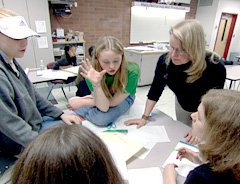How Do Rubrics Help?
How students and teachers understand the standards against which work will be measured.
Rubrics are multidimensional sets of scoring guidelines that can be used to provide consistency in evaluating student work. They spell out scoring criteria so that multiple teachers, using the same rubric for a student's essay, for example, would arrive at the same score or grade.
Rubrics are used from the initiation to the completion of a student project. They provide a measurement system for specific tasks and are tailored to each project, so as the projects become more complex, so do the rubrics.
Rubrics are great for students: they let students know what is expected of them, and demystify grades by clearly stating, in age-appropriate vocabulary, the expectations for a project. They also help students see that learning is about gaining specific skills (both in academic subjects and in problem-solving and life skills), and they give students the opportunity to do self-assessment to reflect on the learning process.

Rubrics also help teachers authentically monitor a student's learning process and develop and revise a lesson plan. They provide a way for a student and a teacher to measure the quality of a body of work. When a student's assessment of his or her work and a teacher's assessment don't agree, they can schedule a conference to let the student explain his or her understanding of the content and justify the method of presentation.
There are two common types of rubrics: team and project rubrics.
Team Rubrics
A team rubric is a guideline that lets each team member know what is expected of him or her. For example, a team rubric contains detailed descriptions for tasks that will be done while the students are working as a team, and states acceptable degrees of behavior. It also defines the consequences for a team member who is not participating, and lists actions or tasks required of each team member for the completion of a successful project, such as the following:
- Did the person participate in the planning process?
- How involved was each member?
- Was the team member's work to the best of his or her ability?
- Shows the quantitative value of the behaviors or actions.
"For as long as assessment is viewed as something we do 'after' teaching and learning are over, we will fail to greatly improve student performance, regardless of how well or how poorly students are currently taught or motivated." -Grant Wiggins, EdD., president and director of programs, Relearning by Design, Ewing, New Jersey
Project Rubrics
A project rubric lists the requirements for the completion of a project-based-learning lesson. It is usually some sort of presentation: a word-processed document, a poster, a model, a multimedia presentation, or a combination of presentations.
The teacher can create a project rubric, or students can collaborate, helping set goals for the project and suggest how their work should be evaluated. Together, the teacher and the students can answer the following questions:
- What is the quality of the work?
- How do you know the content is accurate?
- How well was the presentation delivered?
- How well was the presentation designed?
- What was the main idea?
Sample Rubrics
Look at these rubrics from several websites, which show team rubrics and project rubrics for various subjects and grade levels.
- Collaboration Rubric for Group Work from a high school science project, San Diego City Schools
- Oral Presentation Rubric from a middle school humanities project, Louisiana Voices
- Written Report Rubric from SCORE
- Math Problem-Solving Rubric from Utah Education Network
- Discussion Participation Rubric ( PDF download) from a ninth grade humanities project, School of the Future
After you've reviewed the sample rubrics, discuss the following:
- What do you think of the different styles?
- Do they meet your expectations of rubrics for the designated grade levels? Why, or why not?
- Which one most closely suits your vision of what you will need? Why?
A recent blog on Edutopia.org by Andrew Miller, "Tame the Beast: Tips for Designing and Using Rubrics," has some great advice for how to work with rubrics.
There are many websites that offer free tools to generate your own rubrics, such as Rubistar. For additional rubric ideas and samples, visit the Assessment & Rubric Information page in Kathy Schrock's Guide for Educators. The rubric section of the Authentic Assessment Toolbox, by Dr. Jon Mueller of North Central College, is also very thorough, with lots of tools and resources.
You will find additional resources about rubrics in the Resources for Assessment section of this guide.
Continue to the next section of the guide, Workshop Activities.
Tips for downloading:PDF files can be viewed on a wide variety of platforms -- both as a browser plug-in or a stand-alone application -- with Adobe's free Acrobat Reader program. Click here to download the latest version of Adobe Reader.